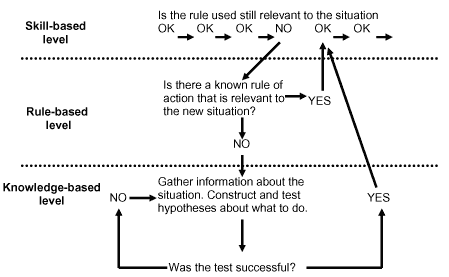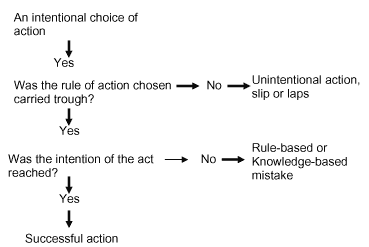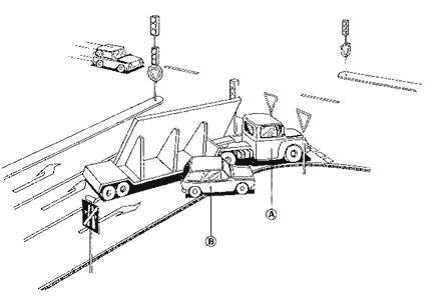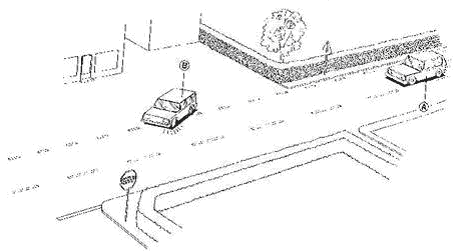
 |
![]()
Linkoping the 1st of October 2003
This paper will present a bottom up perspective on road traffic. Traffic safety is described with the individual accident and the characteristics of the individual road user in focus. This perspective is important as a compliment to the perhaps more powerful top down descriptions as it can offer an understanding of the road user that could help us to find new measures to improve the traffic situation.
Road user behavior is the key to traffic safety. It's almost a definition of an accident that it involves some type of a human error. The road user could be said to be the week link in the road traffic system. On the other had mans tremendous adaptive skill is the most important factor explaining why the road traffic system is rather safe after all. Just imagine what would happen when a traffic signal broke down if the drivers wouldn't be able to adapt to the situation.
In principle we have three methods to control road user behavior: selection of road users, education of road users and adjust the technical part of the system to the road users capacity.
To use tests to try to select those drivers that would be expected to be involved in accidents in the future, in order to prevent them from driving, has of course its background in the idea that some people are more accident-prone than others. This very popular theory has two problems though, which makes it difficult to use. First when we control for differences in experience and exposure there is a rather small variance in accident risk among drivers left. Secondly the precision of the selective tests, that could be used, are so poor that it would be necessary, in order to get any effect of the selection, to prevent so many people from driving that it wouldn't be acceptable. After all it's so important to be able to use a privet car in a modern society that the availability of a driver's license can almost be seen as a human right. The only selection that is made today, at lest in Sweden, to prevent some people from driving is dependent on serious criminality, severe traffic offences like drinking and driving and exceeding the speed limits by more then 30 km/h and different types of disorders.
In contrast to selection education probably is a very important and undervalued method to improve traffic safety. The reason that it has been undervalued is probably because it has been very difficult to show any substantial effects of road user education. A possible reason fore this is that the methods of education or of evaluating the effect of the education are too poor. But it's hardly reasonably to believe that road user behavior would be one of the very few human activities where education wouldn't be effective.
The high accident risk we can see among young drivers all over the world is a challenge to everybody working with driver education. There has been a development during the last years concerning driver education that give some evidence that the following elements could give safety benefits (Engstrom et al. 2003):
Engstrom et al.(2003) especially points on the following trends of driver education in Europe:
When we talk about influencing human behavior we mainly think of pedagogical methods or methods of mass communication to change the attitude of people like advertising and commercials. We often forget the perhaps most important factor influencing human behavior, the preconditions for behavior that the physical surroundings offer. After all if there isn't any goods to buy or money to pay with we will not see any consumer behavior regardless of any advertising efforts. The round about has shown to be a very efficient way of monitoring road user behaviour by the design of the road environment. Brude and Larsson (2003) have shown the round about to be one of the safest types of crossings even safer than signalized and grade separated intersections.
The Danish researcher Jens Rasmusen has presented a model describing how an operator in a technical system controls his behavior in relation to the condition the system offers (Rasmusen 1986). The model is very general why it's possible to use it as a description of how the road user control his behavior in relation to the technical preconditions the vehicles and the road environment offers. Rasmusen is talking about three control levels. Knowledge based, rule based and skill based control. (See figure 1.)

Figure 1. A three level model of an operator's control of his behavior in a man machine system. Freely after Rasmusen (1986). |
Knowledge based control has to be used in new situations of which the road user has non or very little experience. In these situations it's necessary to gather information about the conditions the situation offers and to make up hypotheses about what actions to take. This type of control could be seen as a kind of problem solving and the behavior often have the character of trial and error. Knowledge based control is time and attention consuming and therefore not suitable to be used to control tactical and operative behavior by active road users. Hopefully at least car drivers have so much knowledge of traffic before they start driving on their own that they haven't to deal with the situation as a problem solving situation. But concerning more strategic road user behavior as trip planning, buying vehicles or other decisions of importance to the conditions of the traveling it is of course good to make use of knowledge based control.
The more experience a person gets of a situation the less information he got to gather in order to know what actions to take. He will recognize the situation without analyzing the details and he creates a rule saying how to act in this situation. This means that immediately when he recognizes the situation he knows what actions too take. He executes ruled based control of his behavior. As the control only involves recognizing situations and a choice among a limited number of action rules this control is rather quick and not so attention demanding. This type of control is therefore suitable for controlling the tactical task of road user behavior. That is the decisions the road user makes as he's actually traveling. Examples of tactical driver behavior is decisions about what speed to choose, whether to overtake or not, where to look for crucial information and so on. An important part of the road user education is to help the road user to create safe and efficient action rules. There is god reason to believe that the formation of action rules isn't an intellectual task but rather the result of skill training. This means that driver training isn't some thing that should be done in a very compressed time. We have in Sweden had very god experience of a system where we allow young people to start training car driving with there parents from their sixteenth birthday all thought they will not be allowed to take there driving license examine before they are eighteen.
The third of Rasmusens control levels is called the skill-based control level and is actually the execution of the rules chosen at the rule-based level. This control is very fast and demands very little attention. Skilled-based controlled behavior could be said to be automatic and controlled on an unconscious level. An example of behavior that is controlled at this level is the handling of the controls of the vehicle. Of course it's important that for instance the driver get such training that he manages the operative control of his vehicle on a skilled-based level. Actually I don't think this is a big problem in contrast to the rule-based control where education certainly needs improvements.
A general conclusion that could be drawn from Jens Rasmusens model about the design of the technical part of the road traffic system is that standardization is important. In other words it's important to design the technical part of the system in such a way that the road users easily recognize the situations so that they can choose the correct action rules.
What about human errors? What happens when the road users doesn't manage to control their behavior in a correct way? The British psychologist James Reason has formulated a model of human error partly based on Rasmusens theory (Reason, 1990). Reasons definition of a human error is that the acting person didn't succeed in reaching the intention of his action. In relation to Rasmusen this gives us three main types of errors corresponding to the three different levels of behavioral control slips or lapse at the skill-based level, rule-based mistakes and knowledge-based mistakes (see fig.2)

Figure 2. Classification of human errors. Freely after Reason 1990. |
Imagine a situation where the road user has chosen the correct rule of action but he doesn't mange to act according to the rule. The reason fore this is always some disturbance of the road user's attention and results in an error on the skilled based level. Reason calls these types of errors slips and laps. As an example let's look at an accident which actually has happed and which is illustrated in figure 3.
The lorry driver is very familiar with the situation, as he has been passing the crossing several times every weekday for the last two years. He is therefore aware of the problem with cars sneaking up on the right side of his vehicle as he has to leave so much space on that side in order to make the right turn with his voluminous vehicle possible. It's reasonable to think that the lorry driver in this situation has a rule of action saying some thing like "look right to make sure there isn't any vehicle on your right side, turn on your right flasher, look left to make sure that there isn't any conflicting traffic coming from that side, finally check the right side again before starting the turning maneuver". What went wrong? When the driver looks left he discovers a vehicle coming from that side. As he is in a hurry, to be able to unload his cargo before the staff on his destination would take lunch, he decides to make his right turn before the vehicle from the left reaches the crossing. In his eagerness he "forgets" to make the last right hand check.
Attention misses like this is really a part of human nature, the price we pay for our flexibility. And naturally education isn't effective to minimize this type of errors. A recommendation is of course to design the traffic environment in such a way that the distraction and the optional actions of the road users are minimized. But as long as we won't turn the road traffic system into an automatic system almost independent of the road users we will see errors like this and they are common. This points on the importance of passive safety or injury preventive measures, which although it isn't the subject of this paper, it's important to point out as a necessary part of an effective traffic safety strategy.

Figure 3. Example accident 1. |
A very different type of human errors is what Reason calls rule-based mistakes. In this case the road user has managed to act according to the rule. The problem is that the rule doesn't lead to the purpose or the goal of the action, i.e. it's the wrong rule. As an example let's look at still an other accident which actually has happed and which is illustrated in figure 4.

Figure 4. Example accident 2. |
Figure 4 shows vehicle B standing on a parking area in front of a shop. The parking area is separated from the road only by a painted white line. The intention of the driver of vehicle B is to enter the road and therefore he turns on his left flasher. The driver of vehicle A is traveling on the road in a southern direction. The two vehicles collide on the left side of the road seen from the view of driver A.
The driver of vehicle A sees vehicle B with its left flasher on. This makes him believe that driver B intend to enter the road and travel on in the same direction has he himself. As there is no oncoming traffic he shifts to the left part of the road to let B enter the road and allow him self to overtake vehicle B in a safe way. As you certainly have understood driver A has misinterpreted the intention of driver B, who is going to turn left and travel on in northern direction i.e. in the opposite direction of driver A .
There were two possible interpretations of the situation. Driver A chose the wrong one. This is a typical rule-based mistake. This type of errors ought to be a challenge for the designers of the system. Man is used to verbal communication, which isn't possible to make use of in traffic. Instead we have to relay on our interpretation of the behavior of our fellow road users. It's therefore important to design the technical part of the system in such a way that it minimizes the risk of misinterpretation. In the presented example accident the solution is simple. Separate the parking area from the road by a fence in such a way that it forces the vehicles to enter the road in right angel.
Finally Reason talks about knowledge based mistakes. I.e. errors made because the road user doesn't know what options he has. The road user education ought to be of such a quality that these types of errors would be very rare in the tactical ad operative part of the road users' task. This type of mistake is probably most common in the strategic part of the road users' task. In the accident with the right turning lorry above we found a serious knowledge based mistake. As you remember the driver of the lorry was very familiar with the situation as he had been traveling through that crossing several times every weekday for a couple of years. With a more conscious planning of the transport a much safer road for such an extreme type of lorry could have been chosen as there were several optional roads available.
Human errors have here been described from the road users' point of view as a failure to accomplish the intentions of his action. Road users breaking the traffic regulations could also be described as human errors but of a completely different type. It's definitely errors in the eyes of society as it often increases the probability of accidents to happen and the injuries resulting from the accidents. In the strategy of 0-vision these two types of errors, i.e. errors due to mans imperfection and errors in the sense of road users breaking the law, results in the division of responsibility between the designers of the road traffic system and the road users. It's the designers' duty to make sure that no one is killed or severely wounded as long as the road users don't break the traffic regulations. I find it important to point out that this means that it's important to design the system not only to minimize the consequences of accidents but also to minimize the probability of human errors and there by the probability of accidents to occur.
Traffic safety work has to a large extent been concentrated on the tactical and operative part of road users' task. I think that there is an important safety potential also in the strategic part of the task that often is forgotten. But most important of all is that a successful traffic safety work demands a very broad repertoire of measures. The road users must be given good education and training and the technical parts of the system must be adapted to the characteristics of man in order to minimize the probability of human errors as well as the risk of serious injuries when accidents after all happened.
References
Brude, U., & Larsson, J. What roundabout design provides the highest possible safety? Nordic Road & Transport Research, no.2, 2000.
Engstrom, I., Gregersen, N.P., Hernetkoski, K., Keskinen, E. & Nyberg, A. Young novice drivers, driver education and training - Literature review. VTI report 491A. Swedish National Road and Transport Research Institute (VTI). Linkoping. 2003.
Hatakka, M., Keskinen, K., Gregersen, N.P., Glad, A. & Hernetkoski, K. From control of the vehicle to personal self-control; broadening the perspectives to driver education. Transportation Research Part F, 5 (3), 201-215. 2002.
Rasmusen, J. Information processing and human-machine interaction. An approach to cognitive engineering. North Holland, London 1986.
Reason, J. Human error. Cambridge University Press, Cambridge 1990
![]()